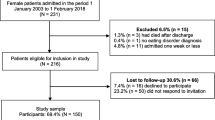Abstract
Few empirical data address naturalistic outcomes of residential eating disorder (ED) treatment. Study aims were to evaluate course, effectiveness, and predictors of outcome in a residential treatment program. We evaluated 80 consecutively admitted female adolescents with the SCID-IV. Primary outcomes were treatment completion, subsequent readmission, clinical global impressions, and changes in body weight. Mean length of stay was 51 days, and 80% of patients were discharged according to treatment plans. Mean expected body weight (EBW) for AN patients increased from 80% to 91%. Patients reported significant improvements in ED symptoms, depression, and quality of life. Low admission %EBW and previous psychiatric hospitalizations were associated with premature termination. Overall, findings support that residential treatment is largely acceptable to patients, and that residential care may provide an opportunity for substantive therapeutic gains.
Similar content being viewed by others
References
Willer MG, Thuras P, Crow S.J. Implications of the changing use of hospitalization to treat anorexia nervosa. Am J Psychiatry 2005; 162: 2374–6.
Treat TA, Gaskill JA, McCabe EB, et al. Short-term outcome of psychiatric inpatients with anorexia nervosa in the current care environment. Int J Eat Disord 2005; 38: 123–33.
Wiseman CV, Sunday SR, Klapper F, et al. Changing patterns of hospitalization in eating disorder patients. Int J Eat Disord 2001; 30: 69–74.
Kong S. Day treatment programme for patients with eating disorders: Randomized controlled trial. J Adv Nurs 2005; 51: 5–14.
American Psychiatric Association. Practice guidelines for the treatment of patients with eating disorders. Am J Psychiatry 2006; 163 (Suppl 7): 4–54.
Howard WT, Evans KK, Quintero-Howard CV, et al. Predictors of success or failure of transition to day hospital treatment for inpatients with anorexia nervosa. Am J Psychiatry 1999; 156: 1697–702.
Frisch MJ, Herzog DL, Franko DB. Residential treatment for eating disorders. Int J Eat Disord 2006; 39: 434–42.
Crow SJ, Nyman JA. The cost-effectiveness of treatment for anorexia nervosa. Int J Eat Disord 2004; 35: 155–60.
Bean P, Weltzin T. Evolution of symptom severity during residential treatment of females with eating disorders. Eat Weight Disord 2001; 6: 197–204.
Geller J, Zaitsoff S, Srikameswaran S. Tracking readiness and motivation for change in individuals with eating disorders over the course of treatment. Cogn Ther Res 2005; 29: 611–25.
Leonard LM. A time-series design evaluating the effectiveness of a residential treatment program for eating disorders. Dissertation Abstracts International: Section B: The Sciences and Engineering 2007; 68: 2657.
McHugh MD. Readiness for change and short-term outcomes of female adolescents in residential treatment for anorexia nervosa. Int J Eat Disord 2007; 40: 602.
Kahn C, Pike K. In search of predictors of dropout from inpatient treatment for Anorexia Nervosa. Int J Eat Disord 2001; 30: 237–44.
Woodside D, Carter J, Blackmore E. Predictors of premature termination of inpatient treatment of anorexia nervosa. Am J Psychiatry 2004; 161: 2277–81.
Willer MG, Thuras P, Crow SJ. Implications of the changing use of hospitalization to treat Anorexia Nervosa. Am J Psychiatry 2005; 162: 2374–6.
Fairburn CG, Cooper Z, Bohn K, et al. The severity and status of eating disorder NOS: Implications for DSMV. Behav Res Ther 2007; 45: 1705–15.
Statistics, N.C.F.H. CDC Growth Charts: United States. Advance Data No. 314. Vital and Health Statistics of the Centers for Disease Control and Prevention, May 30, 2000.
First MB, Spitzer RL, Gibbon M, et al. The Structured Clinical Interview for DSM-IV Axis I Disorders, Research Version, Patient Edition, with Psychotic Screen. New York, Biometrics Research, New York State Psychiatric Institute, 1997.
Spitzer RL, Williams JB, Gibbon M, et al. The structured clinical interview for DSM-III-R (SCID-1): History, rationale, and description. Arch Gen Psychiatry 1992; 49: 624–9.
Fairburn CG, Beglin S. Assessment of eating disorders: Interview or self-report questionnaire? Int J Eat Disord 1994; 16: 363–70.
Reas DL, Whisenhunt BL, Netemeyer R, et al. Development of the body checking questionnaire: A self-report measure of body checking behaviors. Int J Eat Disord 2002; 31: 324–33.
Rosen JC, Srebnik D, Saltzberg E, et al. Development of a body image avoidance questionnaire. Psychol Assess 1991; 3: 32–7.
Beck AT, Steer RA, Brown GK. Manual for the Beck Depression Inventory-Second Edition. San Antonio, Texas, The Psychological Corporation, Harcourt Brace & Co., 1996.
Osman A, Kopper BA, Barrios F, et al. Reliability and validity of the Beck Depression Inventory-II with adolescent psychiatric inpatients. Psychol Assess 2004; 16: 120–32.
Guy W. ECDEU Assessment manual for psychophar-macology. Washington, DC, US Department of HEW Publications, 1976.
Endicott J, Nee J, Harrison W, et al. Quality of Life Enjoyment and Satisfaction Questionnaire: A new measure. Psychopharmacol Bull 1993; 29: 321–6.
Keel PK, Haedt A, Edler C. Purging disorder: An ominous variant of bulimia nervosa? Int J Eat Disord 2005; 38: 191–9.
Treat TA, McCabe EB, Gaskill JA, et al. Treatment of anorexia nervosa in a specialty care continuum. Int J Eat Disord 2008; 41: 564–72.
LeGrange D, Crosby RD, Lock J. Predictors and moderators of outcome in family-based treatment for adolescent bulimia nervosa. J Am Acad Child Adolesc Psychiatry 2008; 47: 464–70.
Geller J, et al. The efficacy of a brief motivational intervention for individuals with eating disorders: Final results from a randomized control trial. Paper presented at the Academy for Eating Disorders, Baltimore, MD, 2007.
Halmi KA. The perplexities of conducting randomized, double-blind, placebo-controlled treatment trials in anorexia nervosa patients. Am J Psychiatry 2008; 165: 1227–8.
Author information
Authors and Affiliations
Corresponding author
Rights and permissions
About this article
Cite this article
Delinsky, S.S., St. Germain, S.A., Thomas, J.J. et al. Naturalistic study of course, effectiveness, and predictors of outcome among female adolescents in residential treatment for eating disorders. Eat Weight Disord 15, e127–e135 (2010). https://doi.org/10.1007/BF03325292
Received:
Accepted:
Published:
Issue Date:
DOI: https://doi.org/10.1007/BF03325292




